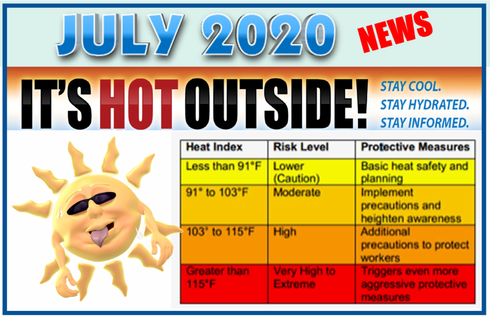Workplace Safety Measures and Heat Illness Tools
Now approaching the summer season heat and as employers begin to return to work (RTW) after months of COVID-19 quarantine, they may be out of shape, out of practice on workplace safety procedures, and will be required to re-breathe hot air through face coverings.
As employers focus on COVID-19 RTW efforts, it is vital that they remain aware of risks of safety rule violations, injuries, and heat illness.
Prepare Employers & Employees for a Hot Summer:
- Have a Written Heat Illness Plan and a post a copy where outdoor employees are working. If you have not updated your plan in the past three years, it will not be compliant with Cal/OSHA’s current rules.Our CalWorkSafety & HR, LLC team can help you quickly update.
- Memorize these three words: Water – Rest – Shade. Ideally, workers require cool water as often as possible, but they may need sports beverages containing balanced electrolytes if they are sweating for several hours at a time. Employers should ensure workers can access shaded or air-conditioned rest areas to cool down as needed.
- New and temporary workers are most at risk. The body takes time to build a tolerance to heat (more than 70% of outdoor heat fatalities occur during a worker’s first week of working in warm or hot environments); building tolerance is called “acclimatization.” Our Heat Safety experts help companies create a Heat Illness Prevention Plan to ensure all employees are fully trained and acclimatized in the 1st work week.
- Indoor workers also suffer from heat illness. Kitchens, laundries, warehouses, foundries, boiler rooms and many other indoor work environments can become dangerously hot. Click below to view Cal OSHA’s workers High-Risk occupation list.
- Use engineering controls or modify work practices to protect employees. By increasing ventilation using cooling fans; scheduling work at a cooler time of the day; rotate job functions among workers to minimize heat exposure. Refer to the Best Practices OSHA resource.
- Familiarize everyone at your workplace with the Signs and Symptoms of Heat Ilness from CDC (Centers for Disease Control & Prevention): and ensure everyone knows what to do in an emergency. This includes:
- Common heat exhaustion signs present: dizziness, headaches, cramps, sweaty skin, nausea and vomiting, weakness, and a fast heartbeat. Heat stroke symptoms may include red, hot, dry skin; convulsions; fainting; very high temperature and confusion. Also: Pair workers with a buddy to observe each other for early signs and symptoms of heat illness … as well as Employees should call a supervisor for help if they believe someone is ill – and 911 if a supervisor is not available, or if someone shows signs of heat stroke. CalWorkSafety & HR offers training materials to help you!
- To help calculate the heat index at your worksite download the iPhone or Android device application – which provides specific recommendations for planning work activities and preventing heat illness based on the estimated risk level where employees are working.
- Ensure workers and supervisors know the location where they are working and how to direct emergency responders to your work site if needed.
- On high heat days, keep extra watch on workers health and stress need to drink water frequently and use cooling off breaks if needed – When the temperature equals or exceeds 95 degrees Fahrenheit.
The OSHA-NIOSH Heat Safety Tool Features offers a visual indicator of the current heat index and associated risk levels specific to your current geographical location; Precautionary recommendations specific to heat index-associated risk levels; An interactive, hourly forecast of heat index values, risk level, and recommendations for planning outdoor work activities in advance; Editable location, temperature, and humidity controls for calculation of variable conditions and Signs and symptoms and first aid information for heat-related illnesses.
As Workers continue to Return to Work After a Prolonged Absence Due to COVID-19
Employers should be more vigilant in refreshing employee training, especially as it relates to heat illness prevention and other safety requirements. Return to work may necessitate generalized retraining on core safety rules. We know that you will face challenging decisions during this national crisis. Please be assured that we are here to help you meet your evolving needs and thrive.
